
Older is better?
This question comes often in whisky forums (and frequently asked to me). Therefore, it might good to dissert about this question and to put into perspective with the changes in whisky production over time.
In this article I will focus on the whiskies distilled after the 1930s. Firstly on the old and aged whiskies (whiskies distilled a long time ago and matured for decades in an oak cask), and secondly on the whiskies distilled in the 1950s-1970s and bottled at a rather "normal" age (10-20 years), the “old" bottles: the core of this article.
The Aged whiskies
Aged whiskies are sold as super (or hyper) premiums, with prices reflecting this positioning. E.g., 50 YO Balvenie and Glenfiddich are sold for over 10’000 euros, or even higher (e.g., Bowmore 54 YO for over 100’000 £), with beautiful decanters, precious wooden boxes and marketed as the finest products you can get for your money. However, the price is a reflection of the rarity of the product and of the brand positioning, not only the intrinsic quality of the product. I have tasted over the years quite a few 40+ year old whiskies: some are really delicious, some are thin, while some might be unpleasantly dry, woody, tannic and/or astringent, as least to my opinion. Over time, the whiskies become mellower and more complex, eventually fruitier, but they also spend more time interacting with the cask. This might result in the wood taking over the character of the distillery. Therefore, aged whiskies might not be necessarily better than the younger ones, but different and eventually of the same “quality”.
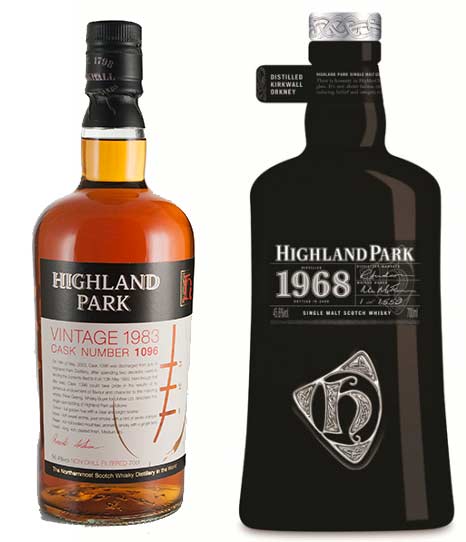 |
| Two whiskies from the same distillery, with the younger version on the left being more expressive and less thin or woody than the old and rare expensive one on the right. |
The demand for aged whiskies is high, but producers have low to very low stocks of old casks. Some of these casks might have gone under strength (i.e., below 40% abv) or due to the evaporation (the “angel’s share”) with only a few liters left in the cask. For example, from a 500 -550 L sherry cask, there might be only 10% left in the cask. So instead of filling 500+ bottles from a 10 year old sherry cask, you might fill only 60-70 bottles with a 30-40 year old cask. Therefore, rarity and yield is a major factor in the pricing of the product, but not necessarily a product superior in quality to more mundane versions of the distillery.
The Old whiskies
During the 20th century, many changes took place in the whisky industry that affected the quality of whisky (malt and blended whiskies). The first major change was linked to legal requirement, with different acts implemented during WWI, forcing the whiskies to be matured for at least 3 years before being sold. Until then, many whiskies were bottled and/or sold straight from the still. While floor malting was still done in most distilleries until the 1960s, the apparition of maltsers and malting drums / pneumatic maltings allowing high volumes of malted barley to be produced and resulted in the progressive closure of the more expensive floor maltings. With the exception of Springbank, no distillery prepares today all its barley on malting floors.
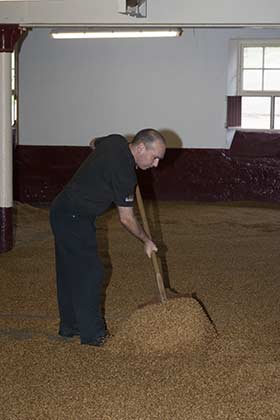 |
| A traditional floor malting. At Balvenie, only a small proportion is prepared on the malting floors (c)www.whisky-news.com |
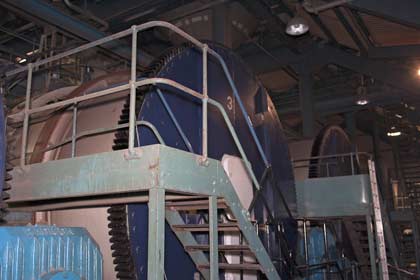 |
| Industrial malting drums at Port Ellen Maltings on Islay (c)www.whisky-news.com |
With progresses in agronomy, the variants of barley changed over time, with distillers looking for strains of barley that would result in the maximal alcool yield. For instance, the Golden Promise which was the main strain in the 1980s is now replaced by strains such as Optic or Chariot. The organoleptic change from one type to the next one is certainly limited, but what about changes in cultivars from the 1950s to 2010s?
To better preserve the malted barley, the barley was malted with different levels of peat, mainly sourced locally. Nowadays, unpeated barley is readily available and the methods of peat extractions have changed and limited to a few commercial producers. The source of peat impacts the final product. There is wide range of unpeated whiskies nowadays, as well as some extremely peated ones.
Once the barley is malted, it goes into a mash tun. With some few exceptions, the old open mash tun have been replaced by closed vessels, either partial or full lauter to increase production. What is the impact of these changes? Very likely to be minimal in the final product.
You need then to add yeast for fermentation. Before, different types of yeasts, usually a combination of brewer’s and distiller’s yeast were added. Nowadays, most distilleries use only distiller’s yeast coming from a few producers. Since yeast in important in the formation of congeners, changes in the type and diversity of yeast are very likely to impact the final product. In Japan, it is considered that the combination of yeast used in their single malts is a very important component for the final product.
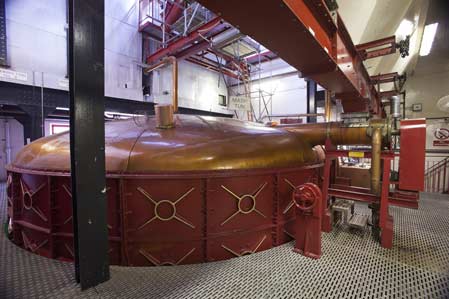 |
| An old traditional mash tun made of corten steel is still in use at Ardmore distillery (c)www.whisky-news.com |
During these steps of production, hygiene has improved, with a decrease in yeast and/or bacterial contamination. Fermentation takes often place in stainless steel washbacks, while wooden washbacks were then preferred. While the shape of the stills might not have changed too much, coal fire stills do not exist anymore in Scotland. Since the 1960s, most distilleries converted from coal direct fire heating to indirect steam heating by gas. Some distillers maintain the use of direct gas fired stills, such as Glenfiddich or Glenfarclas, since they consider that direct fire contributes to unique flavours to their whiskies. To cool the distillate coming off the stills, the traditional worm tubes have been replaced in the majority of the distilleries by tubes in shells condensers, with sometimes the tubes made of steel instead of copper. Condensation is important and some distilleries went back to worm tubes, due to the changes in the quality of their distillate (e.g., Dalwhinnie). At Dailuaine, to produce different styles of spirits, they changed some years ago from copper to steel tubes inside the condenser to produce a more meaty distillate.
The distillate is then matured in casks. Ex-fortified wine casks, mainly sherry, were traditionally used for the maturation of whisky, before cheap ex-bourbon cask became widely available and replaced progressively the ex-sherry casks from the 1930s onwards. Also, since the EU regulations in the 1980s forcing the Spanish sherry to be bottled in Spain, the cask are not anymore discharged in UK to be immediately filled with whisky. Not only the production processes have evolved during the 20th Century, but also the consumer. In particular, starting from the 1970s, when Americans became concerned about their lifestyles and were looking for “light” products, including lighter whiskies. Demand of peated whiskies decreased as well. Instead of drinking their whiskies neat or with some water, whisky was also often consumed with soda and/or ice, especially in warm regions. For this, light whiskies, mainly matured in ex-bourbon cask and unpeated, such as J&B or Cutty Sark were in strong demand.
After WW2, the demand for whisky (blends) was very high and many of the changes mentioned above were made to increase productivity and efficiency. Unfortunately the production did not anticipated the decline in sales between the late 1970s and mid-1980s, mainly as a result of change of consumer habits, with young consumers considering whisky as the “grand-parents” drink and moved towards newer products, mainly vodka. This resulted in huge accumulation of whisky stocks, the famous “whisky loch”, and many distillery closures in the early 1980s (e.g., Rosebank, Brora, St-Magdalene).
The emergence of single malts
In Italy, in 1958, Edoardo Giaccone opened his first whisky bar in Salo. With the growing interest of single malts in his country, he toured Scotland to select the very best casks for his single malts bottlings (the Edwards & Edwards bottlings or Giaccone). Giaccone was the pioneer of single malts in Italy. Other importers (e.g., Sestante, Pinerolo or his former employee Silvano Samaroli) followed his lead and made single malts very popular in Italy during the 1970s-1980s. These whiskies were hand-picked, carefully selected and recognized by many whisky enthusiasts as the pinnacle of single malts whiskies. Having tasting quite a few of these whiskies, I can only confirm the quality of these whiskies. The same is true for several bottlings of Cadenhead’s from this period. Gordon and Macphail bottled some excellent whiskies, especially from Glen Grant.
So, are old whiskies bottles better than the new whiskies?
It might be difficult to beat some of these old single malts. However, we should not forget that we are talking about a small selection of bottles (much less than 1% of the total whisky production). Not old bottles were excellent, some were pretty average, too much reduced (e.g., for some Connoisseur’s Choice), or flawed. Considering the method of production during the 1960s-1970s (and earlier), one would expect that the quality of the whisky was fluctuating over time (for the best or the worst), subject to the spirit cut, quality of the casks, atmospheric conditions, barley harvest, etc. Sometimes the quality of the spirit might have been better than today, but certainly often to a similar level, and sometimes to a lower quality as well. Today, with all the control mechanisms in place, the consistency in production is certainly higher, with lower risks of bacterial contamination, molded barley, poor quality casks, etc…
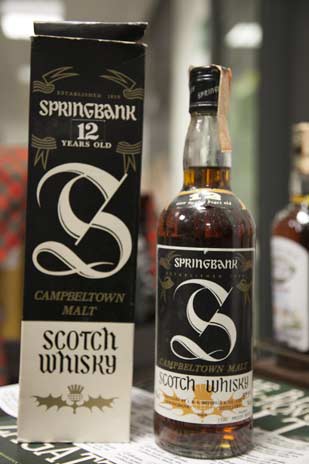 |
| An old legendary bottling: Springbank 12 YO bottled for Samaroli. Such old bottles can still be found in some Whisky Antique dealers in Italy. |
In terms of casks, most distilleries are using exclusively first or second fill casks, while third and fourth fill casks were often used in the 1960s-80s, with sometimes paxerette (a kind of “raisin juice”) injected in the sherry casks to give more color to the whisky. These differences in cask selection would contribute to differences in organoleptic properties. If you use a 3rd or 4th fill casks, the influence of the cask would be very light, but it would allow the character of the distillate to be more apparent, while first and second fill cask would contribute to rather strong oaky notes. Also, today, with the very high demand in casks, the quality of the wood might slightly decline due to supply constraints.
Regarding maturation, whiskies were stored in traditional “dunnage” warehouses where a long maturation took place but resulted in the best quality of the end product. Today, many warehouses are palletised or racked, with high roof and often with a metallic/plastic roof resulting wide ranges of temperature between the low and high section of the warehouse, which might not optimal for the interaction between the oak and the spirit, but this might accelarate the aging.
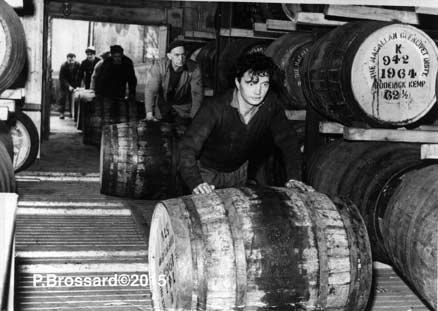 |
| An old traditional "dunnage" warehouse at Macallan in the 1960s, which allowed an efficient airflow betweent the casks |
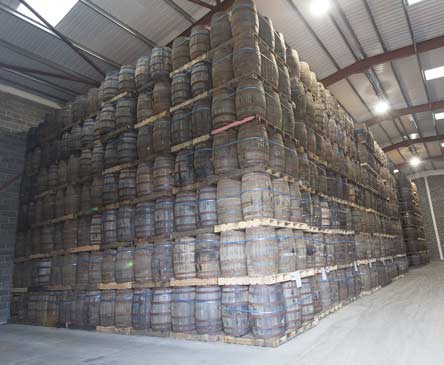 |
| A palletised warehouse at Loch Lomond distillery |
It is difficult to make the case that older is better, since this is a subjective impression. Personally, I tend to like more the old style of whiskies than most whiskies distilled after the 1990s, since I find rather often the influence of first fill bourbon cask, these “oaky” or “modern” flavours, slightly too strong to my liking. For the sherry casks, they tend to be also more rubbery or vegetal, less fruity and/or mineral than some of the casks from the 1960s or 1970s.
Taking some examples, I particularly enjoy the old type of complex peat smoke from the Ardbeg malts distilled in 1974 and 1975, or before the 1970s, where part or most of the barley was malted on site, on the distillery malting floors. In the Speyside, the flavour profile of Glendullan distilled until the mid 1960s is markedly different from the one produced from the 1980s. Probably, the main reason is that whisky was distilled initially in the old still house, then a second and more modern still house was built in 1972, with distillates from both still houses mixed together until the destruction of the old still house in 1985. Linkwood is another distillery which switched of still house over time.
Looking at the iconic distillery of Macallan, according to several whisky enthusiasts and to my personal opinion, the style has changed over time, and more markedly since the launch of the Oak selection, when Macallan changed from a 100% sherry matured to a mixture of ex-sherry and ex-bourbon casks. In the 100% sherry matured versions, the produce has evolved as well, particularly between the 1940s/1950s and 1960s/1970s. During the 1940s, several versions of Macallan were smoky and slightly peaty, since peat was the main combustible available. In addition, in 1950, the still house was rebuilt and the floor maltings closed. A second and more modern still-house was built and both worked in tandem until 1970, when the old one was closed. Considering the difference of size and style of the wash stills between these two still houses, a difference in the spirit is expected.
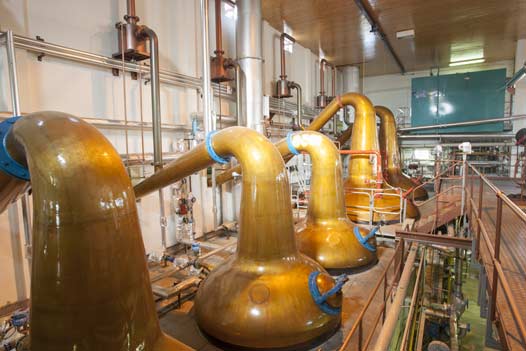 |
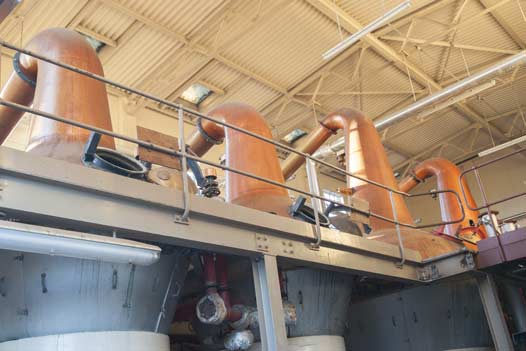 |
| The new (top) and old (bottom) still house at Macallan (c) whisky-news.com |
So, between the 1950s and early 2000s, major changes took place in the whisky production, as well as changes in consumers’ preferences. These changes are likely to have an effect on the end product. For some distilleries, the quality of the products might have been poor due to poor cask management and control of bacterial contamination for some batches. On the other hands, quality of the maturation was very good and some exceptional sherry casks might have lead to exceptional casks of whisky. In addition, for blends or single malts from the later 1990s-early 2000, the consumers might have benefited from the whisky over-production, with several whiskies (e.g., Bunnhahabhain 12 YO, old Springbanks or Littlemills) which had whiskies older than the age on the label. Either, several olders or much older casks were vatted together with young ones or simply, the content of the youngest cask was older than the age on the label. For instance, some Littlemill 12 YO were filled with casks of at least 15-17 year old. The same applied for some blended whiskies as well bottled in the 1980s-90s. However, with maybe the exception of some leading brands. the age of the whiskies used for the blends might have decreased during the 1990s as a result of the fierce competition between supermarkets and the race to push down the prices. Since margins were low and prices continuously pushed down, one would expect that the age and quality of the casks used for the cheap blends to be low. At one time, after the successful launch of Glenfiddich single malts, one of the director of Wm Grants and Sons decided to remove the age statement on the whisky in order to increase its profits by using younger whiskies. Sales declined with the decline of the quality of the product and age statement was re-inserted and quality back to the expectations of the consumer.
I mentioned that I tend to prefer old vs recent whiskies, but several distilleries have improved over time and I prefer a 10-12 YO Glengoyne, Ledaig or Tomatin bottled today than 10-15 years ago.
In conclusion, it might be true that some old whiskies were better than their same modern versions, especially for some selected single casks or limited edition, but today’s production is certainly of a more consistent quality, with less flawed products. And as always, this might depends on your preferences. If you enjoy better a whisky with a strong oaky-vanilla influence than a delicate malt with a light cask influence, then you will definitely enjoy better the current products than the old ones.
Slainte
Patrick